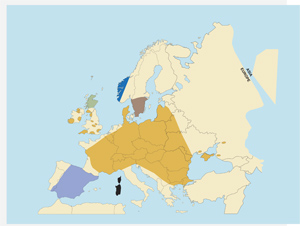European Roe Deer - Europe | Online Record Book Preview
This is a preview of the European Roe Deer - Europe species only.
Once you subscribe you will be able to view all the entry details for hundreds of different species, including full score sheets and photos.
This species has several classifications, to view each one you can click on the links below to jump down to that section:
European Roe Deer - Europe |
|
Cervus elaphus hippelaphus
DESCRIPTION The largest of all red deer, with the finest specimens as regards weight and quality of antlers coming from Poland, Hungary, Romania and the former Yugoslavia. Stags weighing 600-660 pounds (272-300 kg) have been taken, as have antlers with 20 or more points and weighing more than 22 pounds (10 kg) including the frontal bone, or 26 pounds (12 kg) on the cleaned skull. The antlers are usually darker than those from other red deer.
DISTRIBUTION Mainland Europe (except for Scandinavia and the Iberian Peninsula) as far east as the Crimean Peninsula and southern Russia. European red deer have also been introduced in several hunting reserves in areas of European Russia where they are not native.
Those in England and Ireland, and in Scotland south of a line between Glasgow and Edinburgh, are classified as English Red Deer. (The latter are classified as Scottish red deer by biologists, but are treated here as English red deer-the larger form-because of the possibility of hybridization.)
REMARKS For the most memorable experience, the sportsman should probably make his hunt in the mountains of eastern Europe during the roar. If all goes well, he could find himself surrounded by roaring stags that are some of the finest in the world, and see antlers that are unaffordable for most sportsmen.
TAXONOMIC NOTES Includes the montanus race from eastern Europe, which some authorities consider a separate subspecies, and brauneri from Crimea, which some regard as intermediate between the European hippelaphus and the Mideastern maral.
|
Classifications
European Red Deer - Species Detail |
| Scientific Name: |
Cervus elaphus hippelaphus |
Gold: |
346 2/8" |
Gold (Bow): |
224 3/8" |
| AKA: |
|
Silver: |
292 3/8" |
Silver (Bow): |
0" |
| Endangered: |
|
Bronze: |
220" |
Bronze (Bow): |
200" |
| Member |
Taken |
Location |
Hunting Company/Guide |
Measurer |
MOK |
Score |
OR |
MR |
The European Red Deer currently has 383 Entries listed in the SCI Record Book!
Once you subscribe you'll be able to access photos and full socre sheets for all of these entries. Plus you can filter, sort, and search through all species and entries in the SCI database. If you would like to subscribe now to have access to the entire database, please click here.
|
Return to Top
European Roe Deer (typical) - Species Detail |
| Scientific Name: |
Capreolus capreolus |
Gold: |
50 3/8" |
Gold (Bow): |
35 2/8" |
| AKA: |
|
Silver: |
44 7/8" |
Silver (Bow): |
33 2/8" |
| Endangered: |
|
Bronze: |
36" |
Bronze (Bow): |
33" |
| Member |
Taken |
Location |
Hunting Company/Guide |
Measurer |
MOK |
Score |
OR |
MR |
The European Roe Deer (typical) currently has 979 Entries listed in the SCI Record Book!
Once you subscribe you'll be able to access photos and full socre sheets for all of these entries. Plus you can filter, sort, and search through all species and entries in the SCI database. If you would like to subscribe now to have access to the entire database, please click here.
|
Return to Top
European Roe Deer (non-typical) - Species Detail |
| Scientific Name: |
Capreolus capreolus |
Gold: |
57 4/8" |
Gold (Bow): |
40 6/8" |
| AKA: |
|
Silver: |
51 4/8" |
Silver (Bow): |
0" |
| Endangered: |
|
Bronze: |
44" |
Bronze (Bow): |
40" |
| Member |
Taken |
Location |
Hunting Company/Guide |
Measurer |
MOK |
Score |
OR |
MR |
The European Roe Deer (non-typical) currently has 85 Entries listed in the SCI Record Book!
Once you subscribe you'll be able to access photos and full socre sheets for all of these entries. Plus you can filter, sort, and search through all species and entries in the SCI database. If you would like to subscribe now to have access to the entire database, please click here.
|
Return to Top
|




